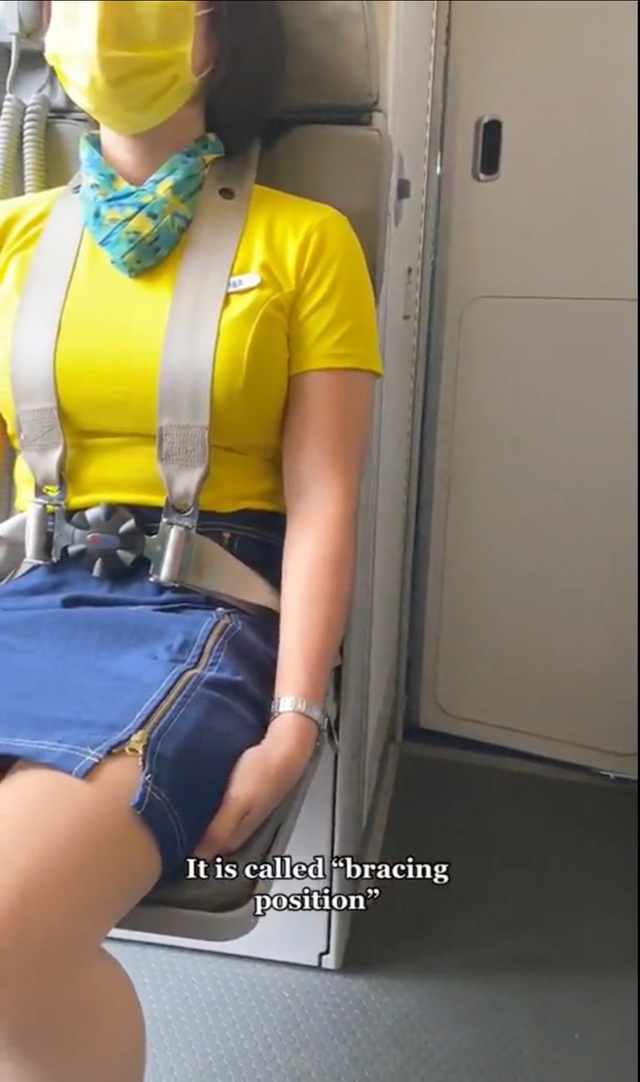Air travel is often associated with comfort, convenience, and excitement. Yet behind the scenes, safety is the primary concern, and flight attendants play a pivotal role in ensuring it. One peculiar action often noticed by passengers is flight attendants sitting on their hands during takeoff and landing. While it may seem odd at first, this practice, known as the bracing position, is a crucial safety protocol. Let’s dive into the reasons behind it and why it’s essential for aviation safety.
Understanding the Bracing Position
The bracing position is more than just sitting still; it’s a well-defined posture designed to protect the body during emergencies. As flight attendant Henny Lim from Cebu Pacific explained in a viral TikTok video, it involves a series of specific steps:

- Securing the seatbelt snugly.
- Sitting upright with feet flat on the floor.
- Placing hands on thighs with thumbs tucked.
- Relaxing the arms while maintaining a steady posture.
This position allows flight attendants to minimize movement, ensuring they’re prepared to react swiftly in case of an emergency. But there’s more to this practice than meets the eye. During these moments, flight attendants aren’t just sitting quietly; they’re mentally preparing for potential scenarios.
The Purpose of the Bracing Position
The primary goal of the bracing position is safety. By maintaining this posture, flight attendants can reduce bodily movement during abrupt impacts, significantly lowering the risk of injury. The rigid position also helps them maintain focus, ensuring they’re ready to act quickly and efficiently in critical situations.
Flight attendants also perform what Lim refers to as a “silent review” during these moments. This mental checklist includes:
- Reviewing emergency procedures and equipment.
- Assessing visual cues outside the aircraft.
- Preparing for specific commands to guide passengers during an evacuation.
This proactive approach ensures that flight attendants are not caught off guard, even in the most unexpected circumstances. Their preparation and calmness during such situations can be the difference between life and death.

Insights from Aviation Authorities
Regulatory bodies like the Federal Aviation Administration (FAA) emphasize the importance of the bracing position for all airline staff. According to an FAA memo, the position serves two vital purposes:
- Reducing Flailing: Uncontrolled limb movement, known as flailing, can lead to severe injuries during a crash. By sitting on their hands, flight attendants prevent this and protect themselves.
- Minimizing Secondary Impact: Positioning the head and body against surfaces they’re likely to hit during an impact helps reduce injury severity. This technique ensures that the body is prepped for the force of collision.
These safety measures highlight the thoughtfulness behind every protocol observed by cabin crew. It’s not just about protecting themselves but being physically capable of assisting passengers during emergencies.

Educating the Public Through Social Media
Social media has become a powerful tool for flight attendants to share their experiences and educate passengers about aviation safety. Henny Lim’s TikTok video on the bracing position is just one example. By demystifying safety procedures, such content bridges the gap between passengers and crew, fostering greater understanding and respect.
Other flight attendants, like Destanie and Esther Sturrus, also use platforms like TikTok to share amusing anecdotes and serious insights. While some posts highlight humorous passenger behavior, others delve into the challenges and rewards of working in the aviation industry. These stories provide a human perspective on what it means to ensure passenger safety while balancing the pressures of the job.

The Challenges and Rewards of Being a Flight Attendant
The role of a flight attendant goes far beyond serving meals and drinks. They’re safety professionals trained to handle emergencies, from medical crises to evacuations. Despite the glamorous perception of their jobs, they face unique challenges:
- Dealing with difficult or uncooperative passengers.
- Managing long hours in high-pressure environments.
- Balancing professionalism with empathy during stressful situations.
Yet many flight attendants speak passionately about the rewards of their work. The ability to travel the world, meet diverse people, and make a tangible impact on passengers’ lives is deeply fulfilling. Most importantly, their dedication to safety remains unwavering, as seen in their meticulous adherence to protocols like the bracing position.
What Passengers Can Learn
While passengers may not be required to assume the bracing position, understanding its importance fosters a greater appreciation for flight attendants’ roles. Here are a few takeaways for travelers:
- Respect Safety Protocols: Always pay attention to pre-flight safety demonstrations and follow crew instructions during takeoff and landing.
- Understand the Role of Flight Attendants: Recognize that their primary responsibility is your safety, not just your comfort.
- Be Cooperative: By adhering to instructions, you contribute to a safer and more efficient travel experience.
Flight attendants undergo rigorous training to keep you safe, and respecting their efforts ensures a smoother journey for everyone.

Conclusion
The bracing position adopted by flight attendants during takeoff and landing is far from a simple ritual. It’s a life-saving measure rooted in thoughtful preparation and designed to protect both crew and passengers during emergencies. Thanks to professionals like Henny Lim, we gain a deeper understanding of these practices and the dedication that cabin crew bring to their work.
The next time you board a plane, take a moment to appreciate the meticulous safety measures in place and the people behind them. By fostering mutual respect and understanding, we can all contribute to a safer and more enjoyable flying experience.



